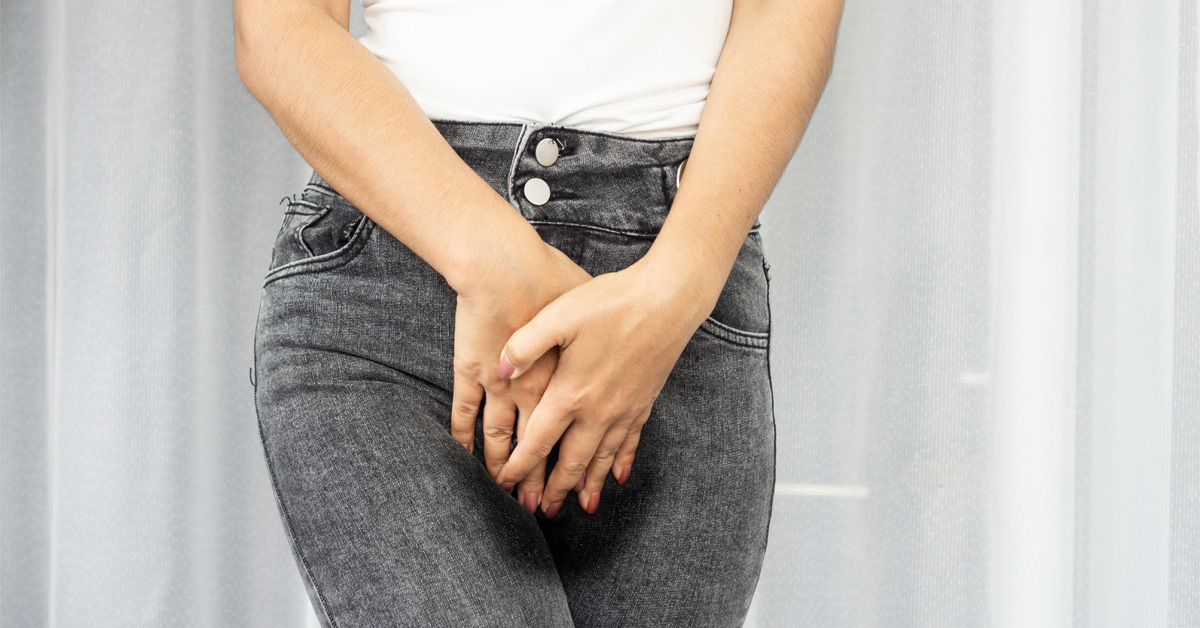
Bladder leakage, also known as urinary incontinence, can cause a significant disruption to your life. Bladder leaks can happen to both men and women for a variety of reasons. Fortunately, there are several effective ways to treat unwanted and embarrassing bladder leakage.
Types of Urinary Incontinence
Bladder leakage is a symptom of urinary incontinence. There are several types of urinary incontinence, including:
- Stress Incontinence: Stress incontinence occurs when excess pressure is placed on the bladder during activities like coughing, laughing, sneezing, jumping, or lifting heavy objects. Stress incontinence occurs when the urethral sphincter or the pelvic floor muscles have been damaged or weakened and cannot hold urine as they should. This type of incontinence is more prevalent in women, especially after childbirth or menopause, but it can also happen to men.
- Urge Incontinence: Urge incontinence, or overactive bladder, is a sudden and intense urge to urinate that often results in bladder leakages, even when you aren’t near a bathroom. People who struggle with urge incontinence may notice their symptoms are triggered by specific activities, like hearing running water or upon arriving home. Urine loss for people with urge incontinence can vary from a few drops to complete bladder emptying.
- Overflow Incontinence: Overflow incontinence is caused by incomplete bladder emptying, which results in chronic overfilling or distention of the bladder. This type of incontinence can occur in both men and women and is usually due to a blockage in the flow of urine out of the body.
- Functional Incontinence: Functional incontinence is the involuntary loss of urine caused by physical limitations, such as poor mobility or cognitive impairment, like dementia.
- Mixed Incontinence: Mixed incontinence is common in women as they age and is a mix of urge and stress incontinence.
Treatment Options for Bladder Leaks
The right treatment option to treat bladder leaks can vary depending on your age, the type of incontinence, and how bothersome your symptoms are. Some common treatment options include:
- Lifestyle changes: A simple and effective method of treating bladder leaks is to make simple lifestyle changes. Some people find that limiting food and drinks with caffeine can help reduce bladder leakages. Others successfully reduce bladder leaks by maintaining a healthy weight, exercising regularly, and quitting smoking.
- Pelvic Floor Strengthening Exercises: Because stress incontinence is typically due to a weakened pelvic floor, many people can reduce their bladder leaks by participating in pelvic floor exercises to increase their muscle tone. Kegel exercises can be used to help strengthen the pelvic floor at home. If needed, physical therapists specializing in pelvic floor physical therapy are available to help teach you how to control your muscles and improve bladder leaks.
- Medications: If lifestyle changes and pelvic floor exercises have not improved your urinary incontinence, your doctor may recommend medications to reduce bladder leaks. Different types of medications are available to help reduce your symptoms, including:
- Anticholinergics: Anticholinergic medications such as oxybutynin (Ditropan XL), tolterodine (Detrol), darifenacin (Enablex), fesoterodine (Toviaz), solifenacin (Vesicare) and trospium chloride, reduce bladder leaks by relaxing bladder muscles and preventing bladder spasms.
- Myrbetriq (Mirabegron): This medication works by relaxing the bladder muscles, allowing the bladder to hold more urine without leaking. It can also help the bladder empty more completely when urinating, which is especially beneficial in people with urge incontinence.
- Alpha blockers: Alpha blockers such as tamsulosin (Flomax), alfuzosin (Uroxatral), silodosin (Rapaflo), and doxazosin (Cardura) are beneficial in men who struggle with urge and overflow incontinence. They work by relaxing the bladder muscles surrounding the prostate to help empty the bladder more completely.
- Anticholinergics: Anticholinergic medications such as oxybutynin (Ditropan XL), tolterodine (Detrol), darifenacin (Enablex), fesoterodine (Toviaz), solifenacin (Vesicare) and trospium chloride, reduce bladder leaks by relaxing bladder muscles and preventing bladder spasms.
- Electrical Nerve Stimulation: Electrical nerve stimulation, like that used in InterStim, uses mild pulses of electricity to stimulate nerves that control the bladder and the sphincter muscles. The pulses can help strengthen the bladder muscles and reduce bladder leaks.
- Surgery: In some cases, surgery may be recommended to help treat persistent bladder leaks. Surgical options can depend on the cause and frequency of your bladder leaks, so it is essential to speak with your doctor to learn more about the best treatments.
Get Treatment for Bladder Leakage
No matter the cause of your bladder leaks, treatments are available to help you regain your quality of life. If you are struggling with bladder leakage and are ready to take action, the first step is to schedule an appointment with an experienced urologist.
Don’t continue to live with embarrassing and inconvenient bladder leakage – schedule an appointment today!
